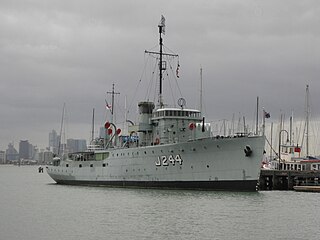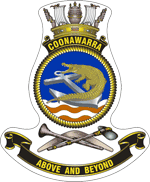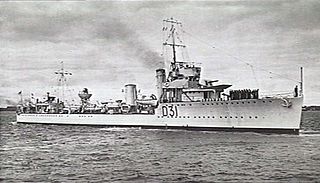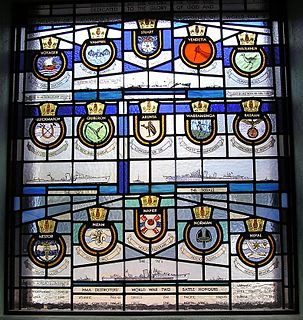Related Research Articles

HMAS Burnie (J198/B238/A112), named for the port city of Burnie, Tasmania, was one of 60 Bathurst-class corvettes constructed during World War II and one of 20 built for the Admiralty but manned by personnel of and commissioned into the Royal Australian Navy (RAN).

HMAS Castlemaine (J244/M244/A248), named for the city of Castlemaine, Victoria, was one of 60 Bathurst-class corvettes constructed during World War II, and one of 36 initially manned and commissioned solely by the Royal Australian Navy (RAN).

HMAS Echuca (J252/M252), named for the town of Echuca, Victoria, was one of 60 Bathurst-class corvettes constructed during World War II, and one of 36 initially manned and commissioned by the Royal Australian Navy (RAN).

The Bathurst-class corvettes were a class of general purpose vessels designed and built in Australia during World War II. Originally classified as minesweepers, but widely referred to as corvettes, the Bathurst-class vessels fulfilled a broad anti-submarine, anti-mine, and convoy escort role.

HMAS Maryborough (J195/B248/A122), named for the city of Maryborough, Queensland, was one of 60 Bathurst-class corvettes constructed during World War II, and one of 20 built on Admiralty order but manned by personnel of and commissioned into the Royal Australian Navy (RAN). She was the first naval vessel built in Queensland for the Royal Australian Navy during World War II.

HMAS Mildura (J207/M207), named for the city of Mildura, Victoria, was one of 60 Bathurst-class corvettes constructed during World War II, and one of 36 initially manned and commissioned by the Royal Australian Navy (RAN). The ship was laid down by Morts Dock & Engineering Co in 1940 and commissioned into the RAN in 1941.

The first HMAS Bendigo (J187/B237/A111) was a Bathurst-class minesweeper, a group commonly known as corvettes and including escort and patrol duties along with minesweeping.

HMAS Coonawarra is a Royal Australian Navy (RAN) base located in Darwin, Northern Territory, and is home to twelve fleet units of the RAN. The current commander is Commander Darren Rushworth, RAN.

HMAS Voyager (D31/I31) was a W-class destroyer of the Royal Navy (RN) and Royal Australian Navy (RAN). Commissioned into the RN in 1918, the destroyer remained in RN service until 1933, when she was transferred to the RAN. Recommissioned, Voyager served in the Mediterranean and Pacific theatres of World War II until 23 September 1942, when she ran aground while trying to deliver troops to Timor. The ship was damaged by Japanese bombers while trying to refloat, then was scuttled by her crew.

HMAS Cairns is a Royal Australian Navy (RAN) base located adjacent to the Trinity Inlet on the shore of Trinity Bay in Cairns, Queensland, Australia. Although used regularly as a port-of-call since before World War II, a permanent RAN presence was not established until 1971, when a maintenance and support base for patrol boats was set up. The base was formally commissioned in 1971 as a minor war vessel base. The current commander of the base is Commander David Hannah, RAN.

HMAS Waterhen is a Royal Australian Navy (RAN) base located in Waverton on Sydney's lower north shore, within Sydney Harbour, in New South Wales, Australia. Constructed on the site of a quarry used to expand Garden Island in the 1930s, the location was used during World War II as a boom net maintenance and storage area. In 1962, the area was commissioned as a base of the RAN, and became home to the RAN's mine warfare forces. Waterhen was the first small-ship base established by the RAN, and from 1969 to 1979 was also responsible for the RAN's patrol boat forces.

The Scrap Iron Flotilla was an Australian destroyer group that operated in the Mediterranean and Pacific during World War II. The name scrap iron flotilla was bestowed upon the group by Nazi Propaganda Minister Joseph Goebbels.
The Australian Patrol Boat Group is a Force Element Group (FEG) of the Royal Australian Navy. It manages the Navy's patrol boats.

HMAS Bathurst (J158), named for the city of Bathurst, New South Wales, was the lead ship of 60 Bathurst-class corvettes constructed during World War II and one of 20 built for the Admiralty but manned by personnel of and commissioned into the Royal Australian Navy (RAN). Constructed during 1940, the ship spent most of her early career operating with the British Eastern Fleet in the Indian Ocean. She returned to Australian waters in late 1944, then was deployed to New Guinea in 1945, but saw little action. Bathurst was paid off in 1946, and sold to a Sydney scrap merchant in 1948.

HMAS Armidale (J240), named for the city of Armidale, New South Wales, was one of 60 Bathurst-class corvettes constructed during World War II, and one of 36 initially manned and commissioned solely by the Royal Australian Navy (RAN).

Following World War II the Royal Australian Navy (RAN) was required to clear naval mines from the waters around Australia and New Guinea. Minesweeping in these areas began in December 1945 and was completed in August 1948. One ship, the Bathurst class corvetteHMAS Warrnambool, was sunk during these operations.

The 20th Minesweeping Flotilla was a Royal Australian Navy minesweeping flotilla that operated during World War II. Formed on 9 December 1939 and styled in the naming convention for minesweeping flotilla names used by the Royal Navy, the flotilla consisted of HMAS Swan, Yarra, Doomba and Orara. The makeup of the flotilla changed during the course of the war.

HMAS Terka (FY.98) was an auxiliary minesweeper operated by the Royal Australian Navy (RAN) during World War II. The ship was launched as Sir Dudley de Chair in 1925 as one of the three ships used to supply the construction of the Sydney Harbour Bridge, and from 1928 operated by the Adelaide Steamship Company until she was requisitioned by the RAN in December 1940. She sank while at her moorings at Madang, New Guinea on 26 March 1945 and was abandoned.
HMAS Tolga was an auxiliary minesweeper which served in the Royal Australian Navy (RAN) during World War II.
References
- "HMAS Armidale (I)". HMA Ship Histories. Sea Power Centre - Royal Australian Navy. Archived from the original on 20 August 2010. Retrieved 5 October 2012.